背光工艺流程
- 格式:ppt
- 大小:4.05 MB
- 文档页数:25
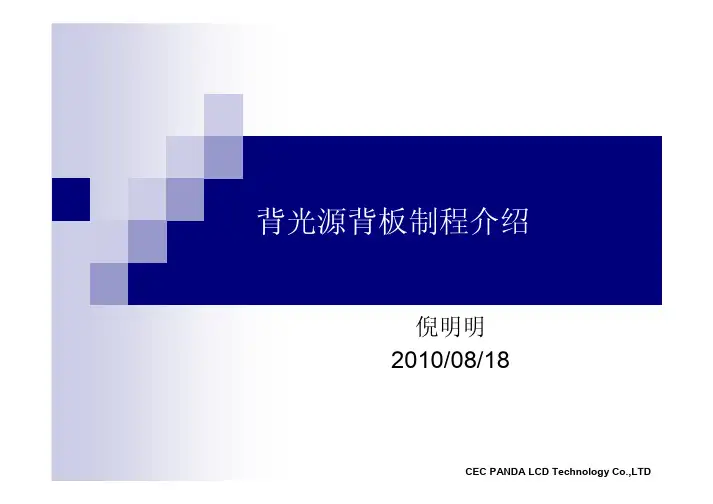
背光源背板制程介绍倪明明2010/08/18目录钣金的定义模具简介钣金相关工艺简介 常用钣金材料背板的制程钣金的定义定义钣金是针对金属薄板(通常在6mm以下)一种综合冷加工工艺,包括剪、冲/切、复合、折、焊接、铆接、拼接、成型(如汽车车身)等。
其显著的特征就是同一零件厚度一致。
模具简介模具定义:工业生产上用以注塑、吹塑、挤出、压铸或锻压成型、冶炼、冲压、拉伸等方法得到所需产品的各种模钣金相关工艺简介下料根据产品图展开后的形状和材料的折弯系数,计算出产品原料的尺寸。
设备:剪床、冲床、NC数控下料、镭射下料等以下图为例:材料厚度0.5mm,假设折弯线为材料的中线,那么张开后材料的长度=19+5+5+0.25π=29.785mm钣金相关工艺简介冲裁用冲模按封闭轮廊曲线冲切,冲下部分是废料。
设备:冲床、模具钣金相关工艺简介折弯折弯就是将2D的平板件,折成3D的零件。
设备:冲床、模具钣金相关工艺简介冲凸包(拉伸)指在冲床或油压机用模具使工件形成凸起形状的工艺过程,一般凸起部分的料厚会小于材料基材的厚度。
深拉伸,高度大过杯内径一般小于杯内径钣金相关工艺简介翻边又叫抽孔、翻孔,就是在一个较小的基孔上抽成一个稍大的孔,再攻丝,主要用板厚比较薄的钣金加工,增加其强度和螺纹圈数,避免滑牙。
孔径<7.5mm的小孔翻边,一次穿刺成型较大孔径,可采用压延模冲孔翻边的方法获得钣金相关工艺简介表面处理喷砂:通过喷砂机喷砂对工件表面进行处理的工艺过程;超音波清洗:使用超音波(>20KHz)并配合相应的溶剂对工件表面进行清洗,主要起到去油,除锈,磷化等作用;氧化:为保护或美观工件而在工件表面形成氧化膜的工艺过程;电镀:为保护或美观工件而在工件表面镀上一层金属的工艺过程;烤漆:烤漆,即喷漆后进烘房加温干燥的工艺。
钣金相关工艺简介其他攻牙:指在工件上加工出内螺纹的工艺过程;碰焊:又称:“点焊”,是指由碰焊机将工件面对面焊接连接的工艺过程;铆接:用铆钉将两个或两个以上工件面对面连接在一起的工艺过程,若是沉头铆接,需将工件先进行沉孔;校形:指对已加工成形出来的工件进行调整的工艺过程。
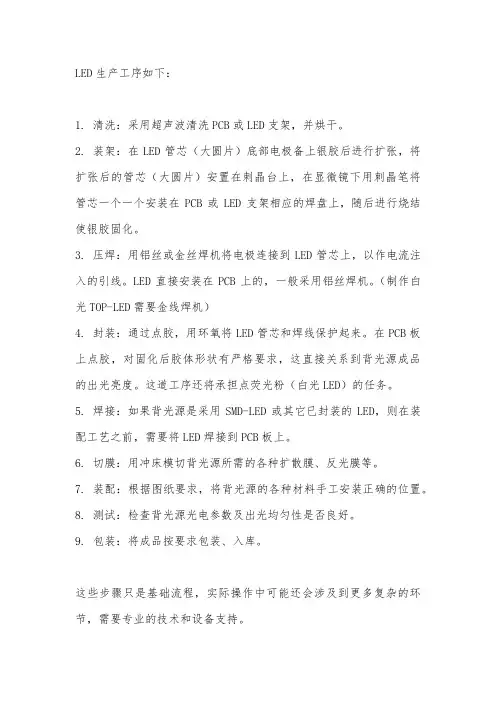
LED生产工序如下:
1. 清洗:采用超声波清洗PCB或LED支架,并烘干。
2. 装架:在LED管芯(大圆片)底部电极备上银胶后进行扩张,将扩张后的管芯(大圆片)安置在刺晶台上,在显微镜下用刺晶笔将管芯一个一个安装在PCB或LED支架相应的焊盘上,随后进行烧结使银胶固化。
3. 压焊:用铝丝或金丝焊机将电极连接到LED管芯上,以作电流注入的引线。
LED直接安装在PCB上的,一般采用铝丝焊机。
(制作白光TOP-LED需要金线焊机)
4. 封装:通过点胶,用环氧将LED管芯和焊线保护起来。
在PCB板上点胶,对固化后胶体形状有严格要求,这直接关系到背光源成品的出光亮度。
这道工序还将承担点荧光粉(白光LED)的任务。
5. 焊接:如果背光源是采用SMD-LED或其它已封装的LED,则在装配工艺之前,需要将LED焊接到PCB板上。
6. 切膜:用冲床模切背光源所需的各种扩散膜、反光膜等。
7. 装配:根据图纸要求,将背光源的各种材料手工安装正确的位置。
8. 测试:检查背光源光电参数及出光均匀性是否良好。
9. 包装:将成品按要求包装、入库。
这些步骤只是基础流程,实际操作中可能还会涉及到更多复杂的环节,需要专业的技术和设备支持。

不锈钢背光字制作工艺-回复不锈钢背光字制作工艺。
一、介绍不锈钢背光字的概念和应用领域(150字)不锈钢背光字是一种广泛用于室内外广告招牌、商场、酒店、商务楼和户外大型广告标识的装饰材料。
它的特点是耐用、耐腐蚀、美观大方,在夜晚通过内部的LED灯光背光,可以展示出独特的视觉效果和吸引力。
二、不锈钢背光字的制作过程(600字)1. 设计和规划:首先,根据客户需求,设计师将制作不锈钢背光字的原型图纸,包括字体、大小、形状和灯光布局等。
2. 材料准备:接下来,根据设计图纸,选择合适的不锈钢板材进行加工。
不锈钢板材一般有镜面不锈钢、拉丝不锈钢和喷砂不锈钢等不同表面处理方式。
3. 切割和钳制:根据设计图纸,在不锈钢板上使用激光切割机将字的轮廓切割出来,并使用电动钳子将边缘进行加工,使其平滑。
4. 焊接和修整:将切割好的不锈钢字母进行排列,然后通过焊接将各个字母焊接在一起,形成一个整体。
随后,对焊接部分进行修整和磨光,以消除焊接痕迹。
5. 维修接线:在字母底部进行内部线路布线和电源接线的操作。
这样,当灯光开启时,整个字母都能被均匀照亮。
6. 表面处理:根据不同的要求,对字母的表面进行不同的处理。
例如,采用拉丝不锈钢的字母可以展现出一种独特的金属质感,而镜面不锈钢则能够产生更光滑、明亮的效果。
7. LED背光灯安装:将LED灯带固定在字母内部。
这些LED灯带根据设计需要被适当地放置和连接到电源上,以确保整体字母能够良好地发光。
8. 安装和调试:最后,安装不锈钢背光字到目标位置,并进行调试。
调试包括检查灯光是否均匀、亮度是否适中等,确保整个字母效果符合设计要求。
三、不锈钢背光字的优势和应用范围(300字)不锈钢背光字的优势包括:1. 耐用性:不锈钢材质具有耐腐蚀和耐候性,能够长时间保持不变形和褪色。
它还能抵御各种天气条件和外界环境的影响。
2. 美观大方:不锈钢背光字可以打造出独特的现代感和高贵气质。
其金属质感、明亮度和光影效果能够吸引人们的注意力。

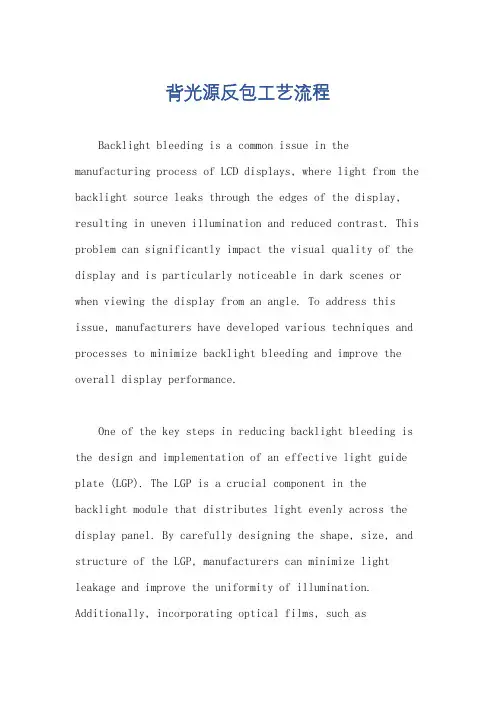
背光源反包工艺流程Backlight bleeding is a common issue in the manufacturing process of LCD displays, where light from the backlight source leaks through the edges of the display, resulting in uneven illumination and reduced contrast. This problem can significantly impact the visual quality of the display and is particularly noticeable in dark scenes or when viewing the display from an angle. To address this issue, manufacturers have developed various techniques and processes to minimize backlight bleeding and improve the overall display performance.One of the key steps in reducing backlight bleeding is the design and implementation of an effective light guide plate (LGP). The LGP is a crucial component in thebacklight module that distributes light evenly across the display panel. By carefully designing the shape, size, and structure of the LGP, manufacturers can minimize light leakage and improve the uniformity of illumination. Additionally, incorporating optical films, such asdiffusers and reflectors, can further enhance the light distribution and reduce backlight bleeding.Another important aspect of the backlight source is the choice of LED (light-emitting diode) technology. LEDs are commonly used as the backlight source due to their energy efficiency and long lifespan. However, the placement and arrangement of LEDs can affect the occurrence of backlight bleeding. Manufacturers employ various techniques, such as using multiple LEDs, placing them strategically, and implementing light guides or light barriers, to minimize the leakage of light and improve display performance.In the manufacturing process, precise assembly and alignment of the backlight module are critical to reduce backlight bleeding. The alignment of the light guide plate, optical films, and other components must be carefully calibrated to ensure optimal light distribution and minimize leakage. Additionally, the sealing of the display panel is crucial to prevent external light from entering the display and causing backlight bleeding. Manufacturers employ advanced sealing techniques, such as optical bondingor using light-blocking materials, to achieve a higherlevel of light isolation and reduce the occurrence of backlight bleeding.Quality control measures play a significant role in minimizing backlight bleeding. Manufacturers conduct rigorous inspections and tests at various stages of the production process to identify and address any potential issues. This includes evaluating the uniformity of illumination, measuring the contrast ratio, and assessing the viewing angles to ensure that the display meets the required standards. By implementing stringent quality control measures, manufacturers can identify and rectify any backlight bleeding issues before the final product reaches the consumer.Lastly, it is important to note that while manufacturers strive to minimize backlight bleeding, it is virtually impossible to completely eliminate it. The nature of LCD technology and the design constraints impose limitations on achieving absolute uniformity of illumination. However, by employing advanced manufacturingtechniques, incorporating innovative designs, and implementing rigorous quality control measures, manufacturers can significantly reduce backlight bleeding and enhance the visual performance of LCD displays.In conclusion, backlight bleeding is a common problem in LCD displays that can negatively impact visual quality. Manufacturers address this issue through various techniques such as designing effective light guide plates, selecting appropriate LED technology, precise assembly and alignment, implementing quality control measures, and using advanced sealing techniques. While it is challenging to completely eliminate backlight bleeding, manufacturers strive to minimize it and improve overall display performance. By continuously advancing manufacturing processes and technologies, the industry aims to provide consumers with high-quality displays that offer enhanced visual experiences.。
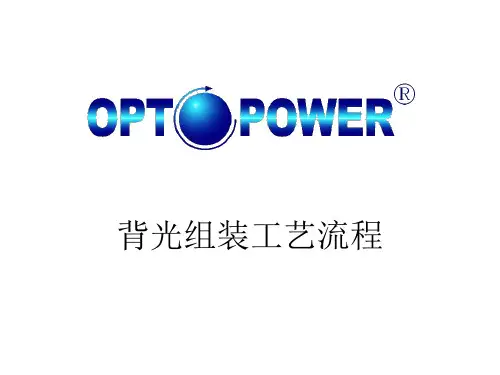


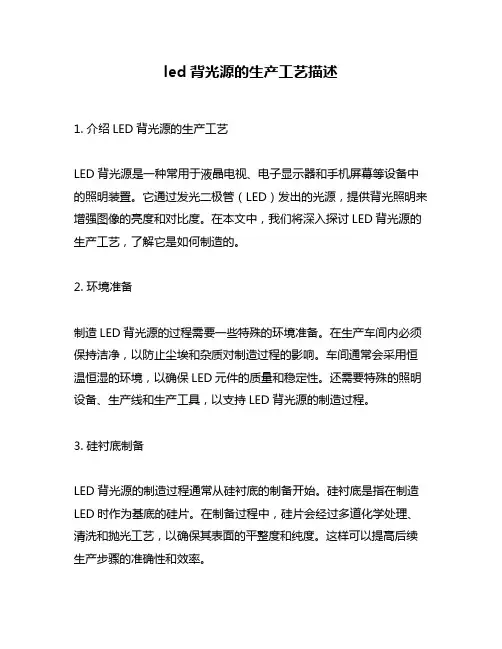
led背光源的生产工艺描述1. 介绍LED背光源的生产工艺LED背光源是一种常用于液晶电视、电子显示器和手机屏幕等设备中的照明装置。
它通过发光二极管(LED)发出的光源,提供背光照明来增强图像的亮度和对比度。
在本文中,我们将深入探讨LED背光源的生产工艺,了解它是如何制造的。
2. 环境准备制造LED背光源的过程需要一些特殊的环境准备。
在生产车间内必须保持洁净,以防止尘埃和杂质对制造过程的影响。
车间通常会采用恒温恒湿的环境,以确保LED元件的质量和稳定性。
还需要特殊的照明设备、生产线和生产工具,以支持LED背光源的制造过程。
3. 硅衬底制备LED背光源的制造过程通常从硅衬底的制备开始。
硅衬底是指在制造LED时作为基底的硅片。
在制备过程中,硅片会经过多道化学处理、清洗和抛光工艺,以确保其表面的平整度和纯度。
这样可以提高后续生产步骤的准确性和效率。
4. 形成和扩散在硅衬底制备完成后,接下来是形成和扩散的步骤。
形成是指通过在硅片表面上制造氮化物或磷化物层来形成LED的结构。
这些层可以通过物理蒸发、化学气相沉积或分子束外延等技术来制备。
扩散则是在LED的表面施加热和压力,以促使硅中的杂质扩散到合适的位置,形成PN结构。
5. 制备荧光粉层接下来是制备荧光粉层的步骤。
LED背光源通常使用荧光粉来转换蓝色或紫色的LED光源为白色光源。
在制备荧光粉层时,会先将荧光粉材料与适量的粘合剂混合,并制备成均匀的液体或固体。
将荧光粉涂刷在已形成的LED结构上,并进行烘烤或固化处理,以确保荧光粉层的稳定性和质量。
6. 封装和封装测试荧光粉层制备完成后,LED背光源进入封装阶段。
在封装过程中,LED芯片会被放置在封装基板上,并用导电胶水固定。
使用薄膜、胶水和导电线连接LED芯片和封装基板,形成完整的LED组件。
在封装完成后,还需要进行封装测试,用以检测和验证LED背光源的性能和质量。
7. 制备背光模组最后一个步骤是制备LED背光模组。
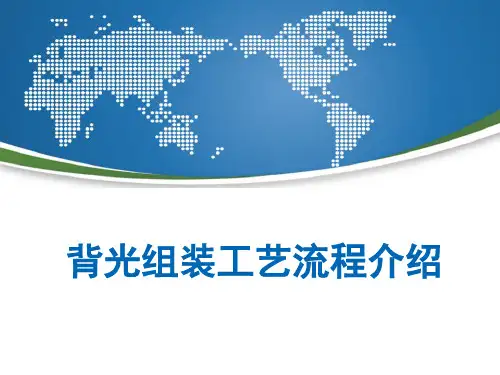
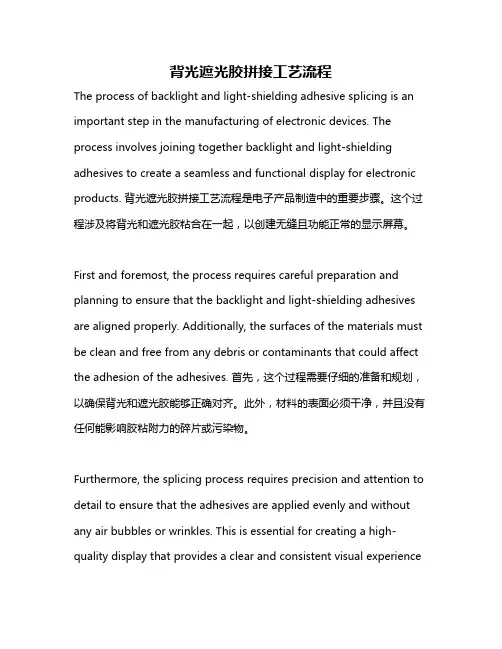
背光遮光胶拼接工艺流程The process of backlight and light-shielding adhesive splicing is an important step in the manufacturing of electronic devices. The process involves joining together backlight and light-shielding adhesives to create a seamless and functional display for electronic products. 背光遮光胶拼接工艺流程是电子产品制造中的重要步骤。
这个过程涉及将背光和遮光胶粘合在一起,以创建无缝且功能正常的显示屏幕。
First and foremost, the process requires careful preparation and planning to ensure that the backlight and light-shielding adhesives are aligned properly. Additionally, the surfaces of the materials must be clean and free from any debris or contaminants that could affect the adhesion of the adhesives. 首先,这个过程需要仔细的准备和规划,以确保背光和遮光胶能够正确对齐。
此外,材料的表面必须干净,并且没有任何能影响胶粘附力的碎片或污染物。
Furthermore, the splicing process requires precision and attention to detail to ensure that the adhesives are applied evenly and without any air bubbles or wrinkles. This is essential for creating a high-quality display that provides a clear and consistent visual experiencefor the end user. 此外,拼接过程需要精准和注意细节,以确保胶水均匀涂抹,并且没有空气泡或褶皱。
键盘背光源生产工艺流程下载温馨提示:该文档是我店铺精心编制而成,希望大家下载以后,能够帮助大家解决实际的问题。
文档下载后可定制随意修改,请根据实际需要进行相应的调整和使用,谢谢!并且,本店铺为大家提供各种各样类型的实用资料,如教育随笔、日记赏析、句子摘抄、古诗大全、经典美文、话题作文、工作总结、词语解析、文案摘录、其他资料等等,如想了解不同资料格式和写法,敬请关注!Download tips: This document is carefully compiled by theeditor. I hope that after you download them,they can help yousolve practical problems. The document can be customized andmodified after downloading,please adjust and use it according toactual needs, thank you!In addition, our shop provides you with various types ofpractical materials,such as educational essays, diaryappreciation,sentence excerpts,ancient poems,classic articles,topic composition,work summary,word parsing,copy excerpts,other materials and so on,want to know different data formats andwriting methods,please pay attention!1. 设计阶段:a. 设计键盘背光源的尺寸、形状和照明效果。